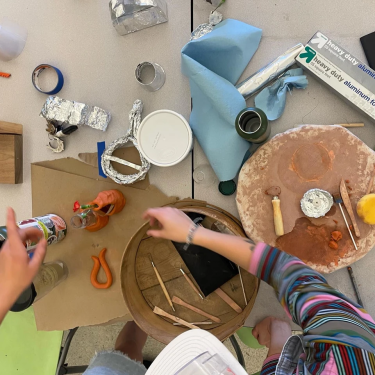![]()
 On Saturday, Nov. 11, at the corner of Pearl Street and 13th Street, the laser cut sign read: Student Designed. Sustainably Built. Nestled in the wooden structure was a half-moon-shaped display of 12 products that students from the third-year intermediate environmental product design studio designed and produced less than three months before. Each one ready to make the perfect gift.
On Saturday, Nov. 11, at the corner of Pearl Street and 13th Street, the laser cut sign read: Student Designed. Sustainably Built. Nestled in the wooden structure was a half-moon-shaped display of 12 products that students from the third-year intermediate environmental product design studio designed and produced less than three months before. Each one ready to make the perfect gift.
At the end of day two of the Firefly Handmade Holiday Market, nine of the 12 products sold out and the EPOP Shop made $7,500 in sales. The funds will be reinvested into the next EPOP studio.
The EPOP Shop made its first pop-up debut during the Environmental Design Open House in December 2019. Teaching Professor Marcel de Lange and Teaching Associate Professor Jeremy Ehly introduced the pilot studio with funds secured through an ENVD-sponsored SEED grant. The environmental product design studio has since been embedded into the ENVD core curriculum for students majoring in environmental product design.
ENVD Teaching Assistant Professor Jared Arp took the lead for the EPOP studio in the fall of 2021 and integrated the first in-person market outcome at a Firefly Handmade market in Denver. “The Firefly seemed like a good fit because of the handmade aesthetic,” Arp said. “It fits the professional level that we perform at, and their market happened to fall towards the end of our semester.” This fall, Arp is co-teaching the studio with Teaching Assistant Professor Melissa Felderman.
 The outcome is more than just setting up shop and selling products at a market. Students learn from and are challenged by the design process and key parameters of sustainability and teamwork. To kick off the fall assignment, students were sent to Pearl Street gift shops to pick out gifts for five different people in their life. The goal: understanding what motivates gift selection and how it differs from other kinds of shopping.
The outcome is more than just setting up shop and selling products at a market. Students learn from and are challenged by the design process and key parameters of sustainability and teamwork. To kick off the fall assignment, students were sent to Pearl Street gift shops to pick out gifts for five different people in their life. The goal: understanding what motivates gift selection and how it differs from other kinds of shopping.
From there, individual product pitches were made. “We asked each student to pitch a product, concept or idea and then students vote on their top 10 or 12, depending on the class size,” Felderman said. Groups of three are formed around each concept, where they collaborate to identify and refine the final form of a sustainably designed product along with quantity. “We think a lot about how much effort goes into reproducing each product. So, we’re encouraging our students to figure out [some kind of a] production or assembly line since there’s three students, how do you take advantage of having three sets of hands to make [products] in the most efficient way possible without sacrificing quality?” 
Group work is the foundation and one of the key parameters of this capstone studio. “Maybe it’s teamwork that makes this studio so unique, probably amongst all of ENVD, I would say,” Arp said. Students perform the entire semester in the same team. “So, it’s a long-term team commitment, which you’ve worked in teams, teams are tough, right? Everybody's got their own agenda. Sometimes communication is tough. One person on the team gets what you said, and the other person misinterprets. We’ve got to get there together, and we’ve got to do it quickly. They’re learning team dynamics.”
From the student perspective, teamwork is an experience they do not take for granted. “I feel like working in a group can be kind of a pain,” Owen Forsythe, a third year EPOD student from Crested Butte, Colorado said. “But at least our experience has been nice. Each one of us has a specialized skill set that maybe the other person doesn’t have. So, we’ve been able to teach each other what to do through the design process.” Forsythe's team, which includes Mia Colletto, a third year EPOD student from San Francisco and Chloe Lapierre, a third year EPOD student from Cape Cod, developed Round 2, glassware inspired by the 14er mountains of Colorado made from recycled wine bottles.
While Arp and Felderman lead the course, the duo expressed that the students deserve all the credit. “It’s the students. They’re incredible. They’re going to design the store, they’re going to merchandise it, they’re going to build it, they’re doing everything we’re advising,” Arp said. “It’s something really beautiful to watch them work like that,” Felderman said.

